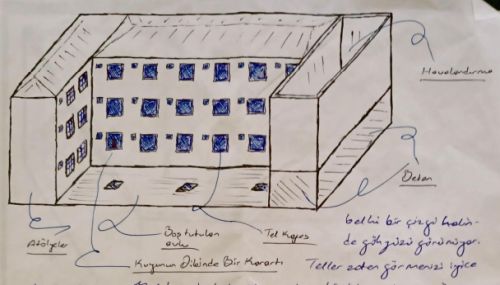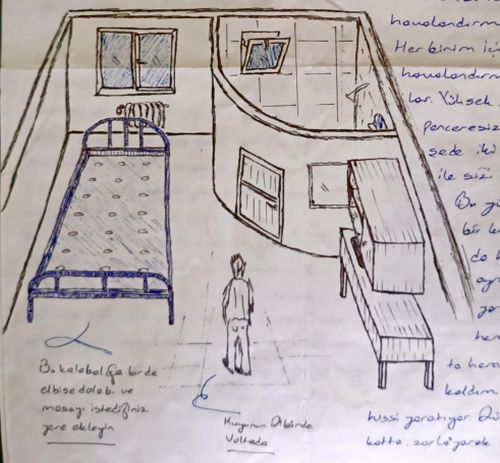
Let us start by getting to know you. Can you briefly tell us about CİSST and your work?
As CİSST, we were founded in 2006 to protect the rights and freedoms of prisoners in prisons, which are among the most high-risk places in terms of human rights violations, and to ensure that prisons comply with international human rights standards and human dignity.
In line with these objectives, we carry out advocacy, monitoring and evaluation activities. We file human rights applications on reports of rights violations by prisoners and their relatives, track the results and report on them. We also submit requests for information about prisons and share the data we receive with the public. In this way, we aim to ensure that civil actors, academics and relevant professional groups, as well as the public, have access to accurate data on prisons and are motivated to engage with prisons.
We know that you have recently focussed on type S and Y prisons, which have been increasing in number. Why are these prisons on your agenda?
The reason why we have focussed on S and Y type prisons and wanted to put these prisons on the agenda is that prisons are built with a focus on isolation and solitary confinement and create harsh conditions for prisoners.
Type S and Y prisons, like type F prisons, belong to the category of ‘high security prisons’. In addition to type S, Y and F prisons, there are also maximum security prisons such as the closed maximum security prison Dumlu No. 1, which do not fall into any category but have a similar architecture to type S and Y prisons. The official authorities do not give sufficient explanations about the S and Y type prisons and do not provide sound information about the conditions and architecture of these facilities. It is said that only prisoners and detainees are housed in maximum security prisons, which are considered to be specially built for severe life sentences and which would negatively affect institutional order.
The lack of official data and information on S and Y type prisons has made it necessary for us as CİSST to establish our own monitoring activities. We have been collecting information on high security prisons for a long time by using monitoring tools such as correspondence with prisoners, hotline calls and lawyer visits. Since 2021, we have identified 714 rights violations in S-type prisons, 38 in Y-type prisons and a total of 1239 rights violations in prisons designated only as high-security prisons.

So, what is the difference between S and Y type prisons and F type prisons?
F type prisons, which adopt the social isolation model, took their place in the execution system in the 2000s. S and Y type prisons, on the other hand, are more isolated structures where isolation conditions are more severe compared to F type prisons. While F type prisons have both wards and cells, S and Y type prisons only have cells. While F type prisons have a separate independent ventilation area for the cells, S and Y type prisons do not have an independent ventilation area and prisoners are taken to a separate area by the prison guards to be aired for one hour. S and Y type prisons are prisons where prisoners are not allowed to communicate with each other in any way. In other words, prisoners who are not aggravated life convicts in S and Y type prisons are also held in aggravated life execution conditions.
In addition to all these, it is also reflected in the public opinion that prisoners in S and T type prisons are subjected to intensive strip searches on their way to and from prison, standing counts are imposed, and cells are monitored with cameras. With all these negative features, it is seen that S and Y type prisons are subject to a stricter execution regime and rules compared to F type prisons.

What are the effects of isolation in these prisons on prisoners?
Isolation is a human rights violation that we, as CİSST, particularly focus on and bring to the agenda. While prisoners were previously subjected to isolation as a means of punishment from time to time, prisoners who received aggravated life imprisonment and prisoners who were held in S and Y type prisons, although they did not receive this sentence, are now held in isolation for the entire duration of their incarceration.
It is known that physical and psychosomatic diseases such as stomach problems, neck and back pain, and eye problems may occur in prisoners held in isolation conditions due to anxiety. At the same time, it has been determined by scientific research that social isolation and lack of social support increase stress and many other psychological disorders. Stress also increases the likelihood of developing cardiovascular diseases and triggers depression and many other psychological disorders.
In our book titled “Being a Prisoner with an Aggravated Life Sentence in Turkey”; we draw attention to the extreme anxiety of some prisoners about the future, their fears about whether they will lose some of their physical abilities, and their concerns about entering social environments in the future and whether they will be able to adapt to the new world order where technology is developing.
In Turkey, the fact that prisons are closed to civilian surveillance leads to rights violations
What concrete examples do you know of the isolation conditions and human rights violations caused by the architectural structure of S and Y type prisons for prisoners? What impact do these prisons have on prisoners who have not been sentenced to life imprisonment?
Due to their architectural structure, type S and Y maximum security prisons lead to serious rights violations for prisoners, even without the intervention of third parties, and violate their fundamental rights by keeping prisoners in isolation. Prisoners, who are constantly recorded by cameras, are deprived of their right to privacy. Contrary to international standards, their right to ventilation is limited to one hour per day. Prisoners are unable to socialise with each other and social isolation deepens. The structure of the windows, which block daylight, combined with the lack of ventilation, has an additional negative impact on the prisoners' health. Their right to visit is severely restricted and prisoners can only meet with their visitors individually. The automatic opening and closing of the doors harbours risks for emergency situations. In short, “aggravated life sentence” is also applied to prisoners receiving lighter sentences, resul,
ting in serious human rights violations.
Is there anything you would like to add?
As CİSST, we are committed to protecting the rights and freedoms of prisoners detained in S and Y type prisons. We want to ensure that these prisons comply with international human rights standards and human dignity in terms of rights, conditions and practises. However, the fact that the prisons in Turkey are closed to civilian supervision hinders these efforts.
We emphasise once again that the psychological effects of isolation and prolonged detention need to be thoroughly researched and that prisons should be opened to academic studies and civil society organisations working for human rights in this regard. The construction of S-type, Y-type and maximum security prisons, which are inherently against human rights and whose architecture, conditions and order make execution an aggravated punishment, should be stopped. Existing prisons should no longer be used unless they are closed and brought into compliance with international human rights standards.
If you would like to receive more up-to-date information, you can visit our website.

